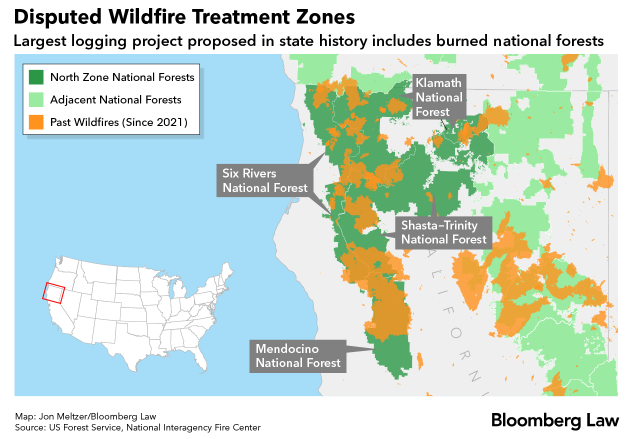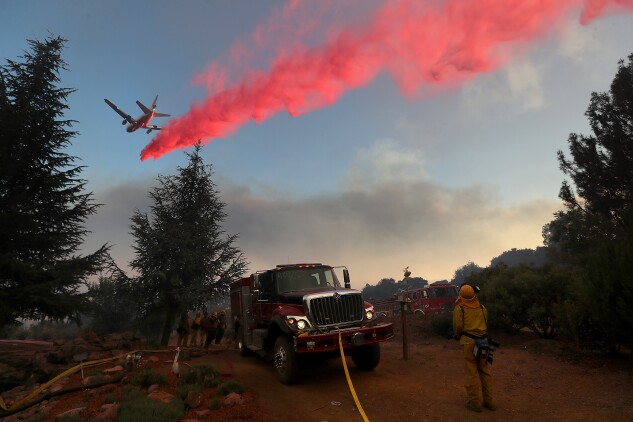- Environmentalists say USFS abuses discretion to favor logging
- Loper Bright offers new avenues to challenge project studies
The US Forest Service is fighting to keep in place a plan to raze the equivalent of 500 Central Parks in California’s forests as wildfires ravaging the southern part of the state put a spotlight on the agency’s management of these natural disasters.
What stands in its way, however, are environmental groups that are relying on a legal strategy that emerged only last year through the US Supreme Court’s ruling in Loper Bright Enterprises v. Raimondo, which tossed a 40-year-old legal doctrine that had deferred to federal regulators’ interpretations of unclear laws.
The Forest Service says the massive clearance is necessary to prevent the kind of wildfires that swept through the state in 2020 and 2021, burning 6.9 million acres, destroying 14,900 structures, and killing 36 people, according to CalFire data.
For such a mass logging, the agency conducted a single environmental study and concluded that no significant effects would stem from removing burnt or damaged timber in nine national forests.
But conservationist groups like the Center for Biological Diversity, which are alarmed at the extent of the logging, contend that those studies represent an agency losing its expert edge. They say the expanded frontlines to fight increasingly volatile wildfires are leading to generalized, potentially inaccurate Forest Service studies.
It’s a playbook that the environmentalists will use to protect the National Environmental Policy Act’s mandated review process.
The second Trump administration hasn’t offered direct signals on what future Forest Service policy will look like. But considering that the first Trump administration significantly tightened deadlines for environmental studies and rolled back required climate change analyses, conservation groups expect to invoke Loper Bright in future lawsuits.
“The agency’s era of deference to its scientific determinations is probably waning because the Forest Service doesn’t actually have a corner of the market on science,” said Susan Brown, principal and chief legal counsel at Silvix Resources, a nonprofit environmental law firm based in Portland, Ore. Brown previously co-chaired the national advisory committee that guided the latest iteration of the National Forest System land management plan.
While Brown has litigated against forest plans she says were unquestionably “timber grabs,” she believes the Forest Service predominantly protects old growth while pushing for wildfire fuel reduction around rural communities.
The environmental groups’ cases pending in the courts question the agency’s discretion to weigh public interest over forest conservation while testing whether courts can set new environmental review standards for natural resource regulations. How judges receive the growing scale of logging projects could signal the next four years of litigation set to challenge mass approvals of drilling and development on public lands.
“Enterprising attorneys are going to find ways to put holes in that agency deference because yes, the case law will tell you the Forest Service is an expert agency,” Brown said. “Well, are they really?”
‘Problematic’ Baseline
Activists’ challenges piled up well before the Los Angeles fires broke out last month, reviving fears over climate change’s ability to exacerbate natural disasters and unleash billions of dollars in damage.
The images of thousands of homes destroyed at the foot of the Angeles National Forest brand the final days of a federal environmental regulatory regime criticized for an inconsistent approach, according to environmentalists working in the field.
President
In early January, Forest Service chief Randy Moore announced that the agency abandoned the National Old Growth Amendment to the National Forest Plan, scrapping an effort to establish a federal baseline to protect mature and old-growth trees in the country’s 154 national forests.
Two weeks later, the US House of Representatives passed the Fix Our Forests Act (H.R. 471), a bill to create categorical exemptions from environmental reviews for forest thinning projects under the National Environmental Policy Act. Utility and home builder associations have come out in support of the bill, while environmental groups warn the measure could strip public accountability for land management decisions.
While the US Agriculture Department—the Forest Service’s parent agency—didn’t specifically address its plans for Biden-era policies and proposals, a spokesperson said “conducting mechanical thinning and prescribed fire in the right places and at the right times are critical tools in tackling the wildfire crisis.”
Before President
“We’re starting from a baseline under the Biden administration that’s problematic,” said Luke Ruediger, the conservation director of the Klamath Forest Alliance. “There’s a lot of concern that we’re going to see a huge push to increase timber production on federal lands.”
Ruediger joins several groups, including the Center for Biological Diversity, Sequoia Forestkeeper, and American Whitewater, in challenging the massive 400,000-acre logging project in California national forests.
The case is proceeding in the US Court of Appeals for the Ninth Circuit after a lower court held the Forest Service’s policy choice to focus on burned trees’ chance of endangering traffic on public roads “was well within its considerable discretion.”
The plan, dubbed the Region 5 Post-Disturbance Hazardous Tree Management Project, allows for damaged trees within 300 feet of the roads to be cut or removed entirely. According to the groups’ suit, potentially millions of trees could be felled as a result.
For what could amount to the largest logging event in California’s history, the Forest Service published a “finding of no significant impact” through an environmental assessment, one of the less-stringent study methods required under the National Environmental Policy Act.
Over 2,000 comments were submitted after the study was published, with groups and residents near the impacted National Forests questioning why the agency couldn’t propose a project more focused in scale, such as cutting only designated “higher-use” roads and omitting the emergency routes open to only high-clearance vehicles.
The agency defended its decision to “heavily weigh the scales in favor of safety,” as it is impossible to predict what tree could fall at any moment onto a road, trail, or facility.
With that logic, environmentalists argue, the Forest Service asserts its right to cut any number of trees under the guise of safety concerns without calculating the chance for harm to forest visitors.
“That’s what can be extremely frustrating here, because they’re really using their discretion to err heavily on the side of logging, instead of taking a look at the broader picture,” said Justin Augustine, an attorney for the Center for Biological Diversity.
The Forest Service rebutted those claims, saying the agency is committed to ensuring mature and old growth forests “are more resilient to the current onslaught of threats.”
“While I understand that a vocal minority like to throw the word ‘logging’ out to evoke fear, we must move past this as the classic ‘boogeyman,’” Wade Muehlhof, an officer with the agency’s national press team, said in a statement. “We know that the work we are doing through the Wildfire Crisis Strategy combined with the numerous efforts across the country to combine strategic thinning with the use of prescribed fire in the right places will ensure that our treasured spaces have the best shot at long term survival.”
Agency vs. Experts
Challenges to logging projects that invoke Loper Bright could shift from simple reviews of the administrative record to trial and discovery processes, where agency employees are deposed and a battle of the experts determines whether chainsaws will touch a forest or if vegetation stays.
Nearly a dozen challenges pending in federal court question whether the Forest Service’s public safety concerns justify large-scale logging operations.
Over the course of the Biden administration, logging levels steadily crept back up to pre-pandemic levels, breaching 3 billion board feet sold in fiscal year 2023. The increase in cutting coincided with a $5 billion infusion for hazardous fuel reduction from the Bipartisan Infrastructure Law, and year-over-year budget increases for wildland fire management and risk reduction as the Agriculture Department recognized that climate change “is increasing the severity and frequency of wildfires.”
Environmentalists support a well-funded Forest Service but want that money to support targeted mitigation tactics like underbrush clearing and prescribed burns. The Los Angeles forests that ignited last month operate under a national wildland fire management strategy that says the existing system “has not kept pace with demands” and requires more proactive treatments. However, activists doubt these precise methods can reassure congressional representatives looking to fund mitigation efforts for a growing share of constituents who are living close to fire-prone wildlife.
The Forest Service has substantially increased the size of wildfire risk management zones in the Western US in the past three decades as housing developments touch more wildlands, keeping “the war against wildfire front and center in the check writers’ minds,” said Andy Stahl, executive director of Forest Service Employees for Environmental Ethics, a nonprofit environmental advocacy and litigation group.
Scientific Jury Still Out
As thinning projects grow larger, stakeholders in forest conservation have yet to reach a consensus on the most effective fire suppression tactics—especially as prolonged droughts and changing weather patterns blow small flames into megafires at unprecedented speeds.
The Forest Service has defended its landscaping methods as tactics meant to change fire behavior away from towns and keep mature trees resilient as water grows scarce in overgrown ecosystems.
However, when the rare wind-driven wildfires spring up in extremely dry conditions, “thinning is not going to do a darn thing,” said Erica Fleishman, director of the Oregon Climate Change Research Institute and a professor at Oregon State University. “It is a combination of dangerous and ineffective to try and suppress it.”
To snuff fires in overgrown forests, thinning projects must continue over years as new, nonnative vegetation overtakes the buffer zones cleared, Fleishman said.
Environmental advocates and scientists alike expressed concern over how the remnants of the wildfire mitigation funds will be spent or if they will dry up all together under the new Trump administration.
After both Trump and Elon Musk fueled overregulation theories online about what caused the LA wildfires, the Sierra Club said “a century of mismanagement” compounded with extreme drought conditions exacerbated by climate change cause small fires to grow into conflagrations.
The Sierra Club has received funding from Bloomberg Philanthropies, the charitable organization founded by Michael Bloomberg. Bloomberg Law is operated by entities controlled by Michael Bloomberg.
Either way, the Forest Service is in a difficult position to defend its methods both in the public view and in front of federal judges.
Megafires have grown to become one of the most unpredictable and destructive ecological phenomena, and “there’s the human tendency to want an easy solution and to want an easy culprit,” Fleishman said. “There isn’t one.”
To contact the reporter on this story:
To contact the editors responsible for this story:
Learn more about Bloomberg Law or Log In to keep reading:
See Breaking News in Context
Bloomberg Law provides trusted coverage of current events enhanced with legal analysis.
Already a subscriber?
Log in to keep reading or access research tools and resources.


